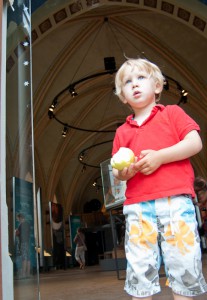Today I attended the conference ”Sharing is caring – digital cultural heritage for all”. Lots of interesting presentations and discussions about how museums can – and should – use digital media, to make their collections more accessible, and to turn their audience into participants.
To do this we of course have to overcome technical obstacles. But probably even more organizational and even mental obstacles. And then there are all the issues raised by copyright and digital rights management. During the discussions of concepts such as Creative Commons and Public Domain, I got a sense of déjà vu. Suddenly it occurred to me: the museum as institution is inherently Public Domain.
Following Krzysztof Pomian, a museum can be defined as a collection of natural or cultural objects taken out of utilitarian circulation, placed under special protection and made accessible to the public. Collections are nothing new in history. But the museum is not just a collection – it is a public collection. The museum, in a modern sense, does not belong to any individual – it belongs to an association, a public authority or the state. The private collection is a subjective endeavour, the public museum is inter-subjective. The museum has durability, independent of a human life span.

The museum has its roots in the era of enlightenment and absolutism. But it acquired its present meaning with the formation of the bourgeois nation state. The museum, as we know it today, is closely connected with the concept of democracy: On one hand, it’s an element in the gradual recognition of the universal human rights to education and cultural fulfilment. On the other hand, the museum is also a vehicle for infusing national sentiments into the citizens, the new subjects of history, and to legitimate the nation-state.
The modern museum rests on the hope, that by looking at the objects – the left-over’s from history – in a certain, scientific way, it is possible to get behind their surface, and gain a deeper understanding of their original context, which we are otherwise separated from in time or space. This is the informative purpose of the museum.
But another, less obvious, but in reality equally important purpose of the modern museum, is the formative one: through our relationship with the objects – whether this relationship takes the form of identification or alienation – we form an image of ourselves as individuals and collectives. The formative role is a result of the simple fact that the museum does not exist in a time warp, but in its own historical context.
Thus, the role of the museum is twofold: it is on the one hand, created for information and understanding, and thus inherently retrospective. In the other hand, it’s created for forming society, and thus inherently oriented towards the present and the future.
The liberal bourgeoisie of the 19th century fully understood this. They build museums in order to be able to mobilize cultural history for their own political project: the museums were the piles of foundation, which bourgeois society hammered into the soil of history. And in a sense there is a parallel between representative democracy and the museum. In representative democracy, there are elections for parliament with regular intervals, but between elections decision-making is the sole prerogative of the politicians. In the same way, society employs museum professionals – not by election, though, but by an intellectual process of elimination – and once employed, interpretation of the past is the sole prerogative of the museum professionals.
Concepts such as web 2.0., social media, crowd-sourcing, etc. is challenging this concept of the museum. The challenge, however, is not new. It has been there for at least 50 years, if not more. An example:
Claims have been made, that it is no coincidence that the youth rebellion so far has totally ignored the museums. They are perceived (…) as repositories for left-over’s from previous societies, and simply not worth the effort.
It is undeniably true that museums are repositories – but they could be much more than that. (…) Exactly because the museums are dealing with all other societies than that, in which we actually live, they could become arsenals, from which arguments could be gathered for criticism of the present; points of departure for new ways of living
These are not the utopian reflections of some radical socialist. It’s a passage in an official report on cultural politics, published by the liberal-conservative Danish government in 1969. It’s not digital media that has put the participatory museum on the agenda. It is a change of political environment, which has made old concepts of citizenship gradually more and more obsolete.
What digital media has done is providing us with new, powerful tool, in our effort to realise the participatory museum. It’s no strange thing, that the museum community is excited about the new possibilities. We should use them to the maximum extent. But we should also realize that we are heading into a process, which is not only about changing the way museums disseminate knowledge and communicate with their audience. It is also a process, which has the potential of changing the formative role of the museum. We need to reflect on this and discuss the role of museums in society, just us as much as we need to discuss open API’s.
Who knows: just as museums in the 19th century acted as vehicles for bourgeois democracy, the participatory museum of the 21st century might be a vehicle for a new, even broader vision of democracy – a participatory democracy. Realising that the museum is inherently Public Domain – and should stay so, also in digital media – might be just a start.
—
Note: The argument is inspired by Krzysztof Pomian: ”Museet: Europas kvintessens”. Den jyske Historiker, nr. 64, 1993. (Sorry, but I’m not aware of an English version).